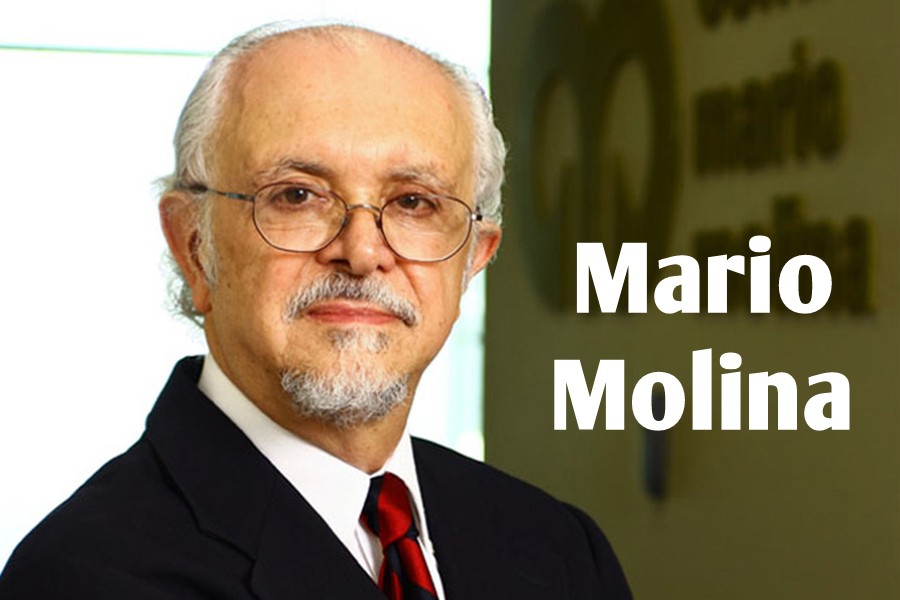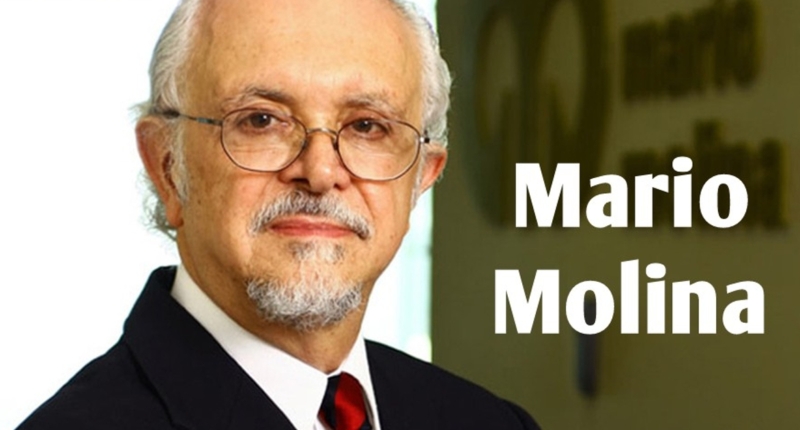Mexican chemist Mario Molina was born on March 19, 1943, in Mexico City. Molina won the Nobel Prize for Chemistry in 1995 for his contribution to the study of the atmospheric effects of man-made compounds, specifically CFCs and their connection to ozone depletion. He worked extensively on environmental chemistry throughout his career and taught at several institutions, including MIT and UC San Diego. Molina received numerous awards for his work, including the Tyler Prize for Environmental Achievement and the U.S. Presidential Medal of Freedom. In addition to his academic and research work, Molina was also a committed environmentalist who served on committees dedicated to environmental preservation. On March 19, 2023, Google celebrated Molina’s 80th birthday with a Doodle featured in several countries.
Mario Molina: A Life Dedicated to Science and Environmental Protection

On March 19, 2023, Google celebrated the 80th birthday of Mario José Molina Henríquez, the renowned Mexican chemist who was awarded the Nobel Prize for discovering the threat of CFC gases to the Earth’s ozone layer. Here are some interesting facts about his life and career.
Early Life and Education
Mario José Molina Henríquez was born on March 19, 1943, in Mexico City to diplomat Roberto Molina Pasquel and Leonor Henríquez. Molina’s passion for science began at a young age, and his aunt Esther Molina, who was also a chemist, inspired him to pursue his interests. At the age of 11, Molina attended “Institut auf dem Rosenberg” in Switzerland after completing his elementary education in Mexico City. Later, he returned to Mexico to study chemical engineering at the “National Autonomous University of Mexico” and earned his bachelor’s degree in 1965.
Postgraduate Studies and Career
After completing his undergraduate studies, Molina continued his education at the “University of Freiburg” in Germany. There he began his postgraduate studies and researched the kinetic rates of polymerization reactions, which led to the publication of his first scientific paper.
In 1968, Molina pursued a Ph.D. in physical chemistry from the “University of California, Berkeley,” where he focused on atmospheric chemistry. After earning his Ph.D., Molina conducted research on atmospheric chemistry at the University of California, Irvine, and later at the Massachusetts Institute of Technology.
In 1974, Molina and his colleague F. Sherwood Rowland published a paper in the scientific journal “Nature,” which warned about the dangers of CFC gases to the ozone layer. Their research led to the discovery that CFC gases break down ozone molecules, leading to a thinning of the Earth’s ozone layer, which protects against harmful ultraviolet radiation. In 1995, Molina and Rowland were awarded the Nobel Prize in Chemistry for their groundbreaking research.
Awards and Recognitions
Throughout his career, Mario Molina received numerous awards and recognitions for his scientific contributions and environmental activism. In 1983, he was awarded the Tyler Prize for Environmental Achievement, and in 1987, he received the Newcomb Cleveland Prize. In 1999, he was awarded the UN Environment Programme Sasakawa Environment Prize, and in 2003, he received the Heinz Award in the Environment. In 2004, he was awarded the Volvo Environment Prize, and in 2013, he received the Presidential Medal of Freedom.
Personal Life
Mario Molina was married twice in his life. He was first married to Luisa Tan from 1973 to 2005 and later to Guadalupe Alvarez in 2006. On October 7, 2020, Molina passed away at the age of 77 in Mexico City, Mexico.
In conclusion, Mario Molina’s contributions to science and the environment have been immense, and his legacy continues to inspire generations of scientists and environmentalists worldwide.
Mario Molina: From Chemistry Student to Environmental Champion
Mario Molina was a Mexican chemist who made significant contributions to the field of atmospheric chemistry, particularly with regards to the effects of human-made chemicals on the ozone layer. Here’s a closer look at his journey.
Pursuing Chemistry Education in North America
Despite having a strong chemistry background, Molina lacked knowledge of quantum mechanics, which he believed was necessary to pursue a career as a physical chemist. To address this, he decided to continue his education in North America, where he could study mathematics as part of the curriculum. In 1968, Molina moved to Berkeley and enrolled at the “University of California,” after spending some time in Paris. He spent his first year learning about advanced physical chemistry, physics, and mathematics.
Research and Discoveries
At the “University of California,” Molina was elected to George C. Pimentel’s research team, where he used chemical lasers to study the distribution of internal energy in the products of chemical and photochemical reactions. In 1972, he received his Ph.D. in chemistry and moved to Irvine the following year to work with F. Sherwood Rowland on research into the chemistry of “hot atoms.”
Molina’s focus shifted to the atmospheric reactivity of inert chemicals released by industries during experiments to understand the properties of atoms formed through radioactive processes. His research on chlorofluorocarbons (CFCs), a major component of many industrial effluents released into the atmosphere, led to the discovery that CFCs had little chemical reactivity in the lower layers of the atmosphere.
However, at higher altitudes, solar radiation breaks down the CFC molecule, releasing chlorine that reacts with the atomic oxygen that makes up the ozone. This leads to the depletion of the ozone layer, which protects the Earth from harmful ultraviolet radiation. Molina and Rowland’s findings were published in the scientific journal “Nature” in 1974 and were referred to as the “CFC-ozone depletion theory.”
Advocacy and Recognition
Molina and Rowland worked to raise awareness about the dangers of CFC emissions among legislative bodies and the general public through the news media. In 1975, Molina was appointed to the faculty at the “University of California” due to his commitment to the ozone depletion theory.
Molina’s contributions to environmental chemistry and advocacy earned him numerous awards and recognition, including the “Tyler Prize for Environmental Achievement” in 1983. He also worked as a senior research scientist at the Jet Propulsion Laboratory of CalTech in the 1980s.
In conclusion, Mario Molina’s dedication to studying the effects of human-made chemicals on the environment and his advocacy efforts to raise awareness about these dangers made him a champion for environmental protection. His contributions to atmospheric chemistry have had a lasting impact on the scientific community and society as a whole.
Mario Molina: A Lifetime of Dedication to Environmental Science
Mario Molina was a Mexican chemist who made remarkable contributions to atmospheric chemistry research. His work on the effects of human-made chemicals on the ozone layer earned him numerous accolades throughout his career. Here’s a closer look at his life’s work.
Continued Research and Teaching
After his tenure at the Jet Propulsion Laboratory, Molina accepted a position as a teacher at the Massachusetts Institute of Technology (MIT) in 1989. In this role, he continued his research on environmental chemistry while also teaching.
In 1989, Molina also took on a dual position at MIT as a professor in the atmospheric chemistry department and a professor in the Earth, atmosphere, and planetary sciences department.
Grants and Publications
In 1990, Molina was one of 10 environmental scientists to receive grants totaling $150,000 from the Pew Charitable Trusts Scholars Program in Conservation and the Environment.
Over the course of his career, Molina has authored over 50 scientific papers, with most of them focused on atmospheric chemistry and the ozone layer. In 1992, he and his wife, Luisa, published a monograph titled “Stratospheric Ozone” in the American Chemical Society book “The Science of Global Change: The Impact of Human Activities on the Environment.”
Awards and Recognition
Molina was awarded the Nobel Prize in Chemistry in 1995, which he shared with Paul J. Crutzen and F. Sherwood Rowland. The trio received the honor for their contributions to studying the atmospheric effects of man-made compounds.
Molina has received more than a dozen other awards throughout his career, including the Esselen Award from the American Chemical Society in 1987, the Newcomb-Cleveland Prize from the American Association for the Advancement of Science in 1988, the NASA Medal for Exceptional Scientific Advancement in 1989, and the United Nations Environmental Program Global 500 Award in 1989. In 2013, Molina received the U.S. Presidential Medal of Freedom.
Continued Advocacy for Environmental Preservation
Molina’s dedication to environmental science continued throughout his life. In 2004, he returned to the University of California in San Diego to teach in the Department of Chemistry and Biochemistry. He also worked closely with earth scientists at the Center for Atmospheric Sciences.
Molina believed that the atmosphere-biosphere interface was “critical to understanding global climate change processes” in subsequent work. He was a committed environmentalist and was associated with several organizations dedicated to environmental preservation, including the Mario Molina Center and the John D. and Catherine T. MacArthur Foundation.
Molina also served as a member of the US Senate’s presidential committee, which provides advice to the president on technological and scientific issues. In 2011, he was one of 20 Nobel Laureates who signed the Stockholm Memorandum at the Third Nobel Laureate Symposium on Global Sustainability held in Stockholm, Sweden.
In March 2014, Molina was in charge of a committee of the American Association for the Advancement of Science that produced a stark report on global warming.
Conclusion
Mario Molina’s lifetime of dedication to environmental science and advocacy for environmental preservation earned him numerous awards and recognition throughout his career. His contributions to atmospheric chemistry have had a lasting impact on the scientific community and society as a whole.
Mario Molina, the Mexican chemist and Nobel Prize winner, is most known for his significant discovery that revealed the connection between CFCs and ozone depletion. Molina’s research led to the implementation of legislation to stop using these toxic industrial effluents. On March 19, 2023, Google released a Doodle to celebrate his 80th birthday. The doodle was featured in several nations, including Mexico, the United States, Brazil, India, Germany, and France, to commemorate the accomplishments of this remarkable scientist.
Don’t miss interesting posts on Famousbio










